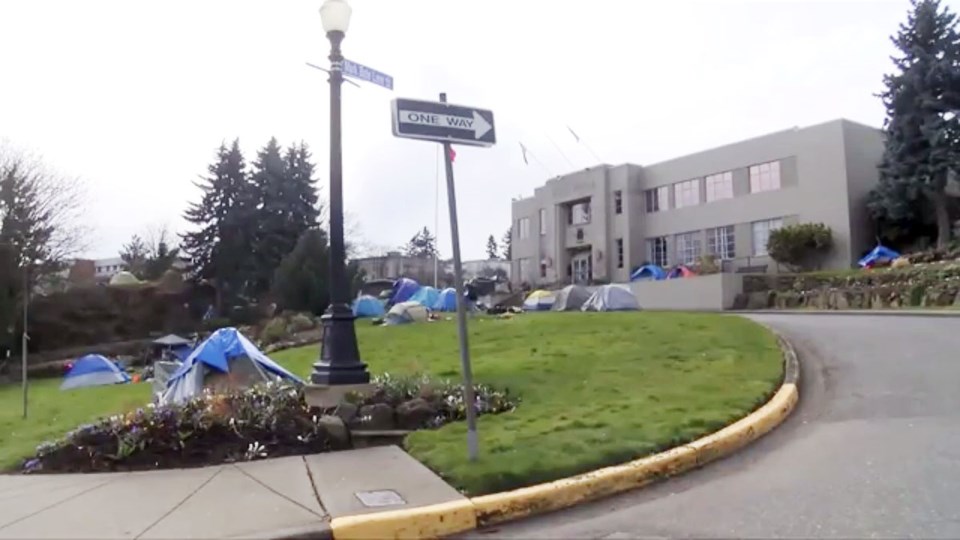Nanaimo’s tent city claimed a small victory on Monday night as municipal politicians agreed to a number of initiatives, including funding for a day-time drop-in centre, that will help the homeless population and those struggling with addiction.
In a rare show of unity, Nanaimo councillors unanimously supported $350,465 in funding, the bulk of which will support a drop-in centre where people living on the street can shower, do laundry or cook. The funding will also pay for enhanced daytime security in the city’s downtown, clean-up teams and additional portable toilets and needle disposal boxes.
The funding was partly in response to the tent city on the lawn of Nanaimo City Hall, which grew over the weekend to about 40 people in two dozen tents. The group is calling for new supportive housing units and resources for at-risk citizens.
Tent city residents and their supporters planned to discuss council’s decision after Monday’s night meeting and will likely decide today whether to take down the protest camp, said community advocate Matthew O’Donnell.
“There are 40 people on your front lawn who don’t have homes,” O’Donnell said. “The million-dollar question is: ‘Will this [funding] provide these homeless people with homes?’ And the answer is no.”
Coun. Jerry Hong reminded O’Donnell that at a previous meeting advocates said the camp would be taken down if funding was approved.
Kevin Donaghy, a spokesman for the tent city group, said supportive housing, with 24-hour staffing and resources, is critical for residents who are homeless or at risk of being homeless.
The number of tents on the lawn of city hall has steadily increased since the first tent went up on March 12. One tent has been used as a safe injection site and outreach nurses have been at the site frequently, Donaghy said.
Citizens have been coming to the tent city to cart away garbage, a portable washroom has been set up, and food, clothing, blankets and camping equipment have been donated, he said
The majority of campers do not have stable housing, said Donaghy, who does outreach and harm reduction work for the Nanaimo chapter of the Society of Living Illicit Drug Users (SOLID). He is also a legal advocate for a community organization.
Protesters are drawing attention to their disappointment that a 44-unit supportive housing project proposed for the Chase River area of Nanaimo fell through this month. The province was ready to spend $7.2 million to build modular housing on city-owned land.
Council decided not to proceed after hearing from angry neighbours who felt the project had been sprung on them with short notice and who worried about safety and a rise in crime.
City hall lost out on that funding and is now preparing to seek other locations that might win community support for a future round of provincial funding. Donaghy said the city “dropped the ball.”
In addressing city councillors Monday night, Donaghy said council could have done more to underscore the need for supportive housing when it was “put in the firing line” by concerned Chase River residents.
Protesters want to see a concrete action plan developed to get the supportive housing plan moving again, with dates and consultation, he said.
Coun. Diane Brennan said support for the $350,000 in funding represents “a major shift for this council.” Nanaimo council has been beset by infighting and dysfunction that has sometimes derailed council meetings. “We haven’t seen this kind of effort in a long time. It’s good to see that we can move [ahead] when challenged.”
At the end of February, Island Health medical health officer Dr. Paul Hasselback criticized councillors for not doing enough to address the opioid overdose crisis. Nanaimo has an overdose death rate that is about 50 per cent higher than B.C. as a whole.
Donaghy estimates that upward of 1,000 people do not have secure housing and are at risk of homelessness in Nanaimo. He believes the homeless population is at about 500; other estimates put it at 300.



